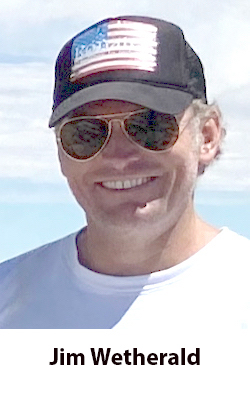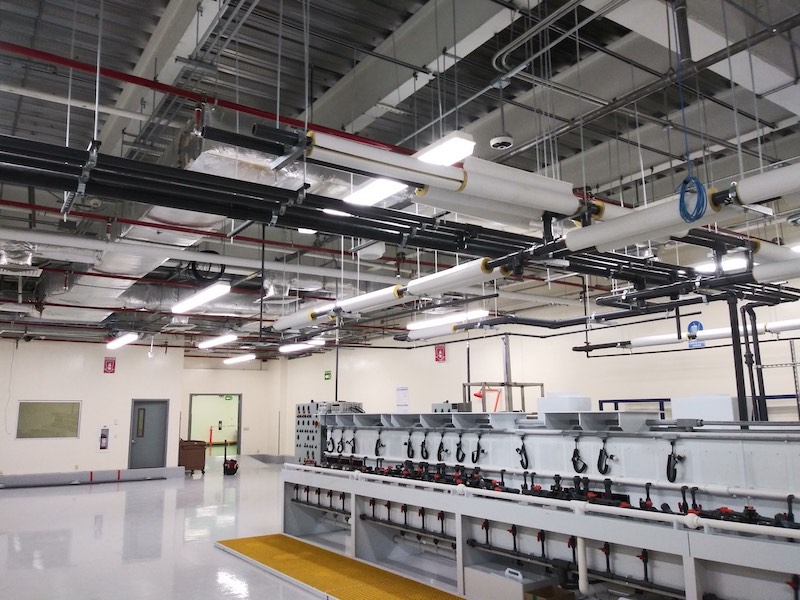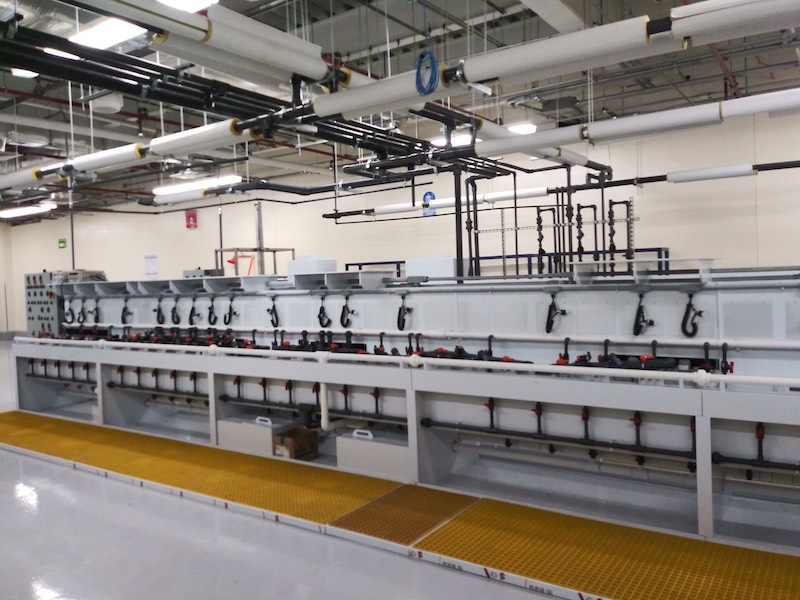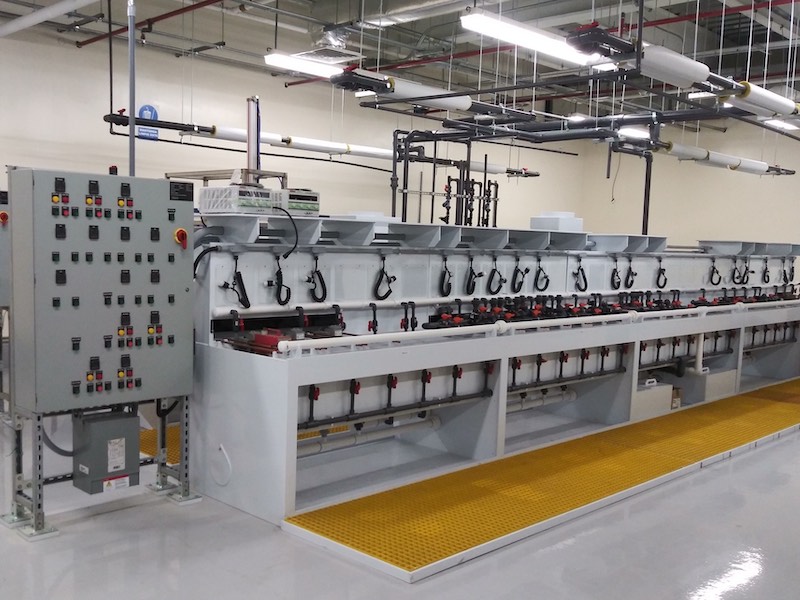This article was originally published in April 2011. A lot has changed in our industry over the past decade, but this article is still referenced quite often and that always makes us smile.
 FinishingAndCoating.com reached out and asked our team to update it with some more relevant data based on the 150+ plating and anodizing lines Ronatec has built since this article was originally published.
FinishingAndCoating.com reached out and asked our team to update it with some more relevant data based on the 150+ plating and anodizing lines Ronatec has built since this article was originally published.
The amount of industry-wide technology upgrades that have become more efficient, smaller, and more cost-effective in the last 9+ years is truly amazing. Self-regenerating Water Recycling Systems @ 15GPM use to cost $300,000, now they are $40,000 and 1/10th the size. Boiler systems use to take up entire rooms, but now we can pack a boiler into a briefcase, and run it with CPVC plumbing, at half the price. Automated plating/anodizing lines were “only for folks plating the same part all day long, not job shops” (I’ve heard that enough times), but now we are building complete automation systems for various industries with literally an infinite number of bath recipes for 100’s of different part sizes.
These improvements have been driven by THIS industry, which demands the best products and most cutting edge technology to maintain American jobs with constant innovation! Americans still build the best products, with the most vanguard machinery/chemistry in the world. Never forget it!
Simply put, it’s a super cool time to be in the metal finishing industry and we can’t wait to see what the next decade brings! We hope we get to update this article again in 2030. We know 2020 hasn’t been the most fun year, but we’re so thankful to have amazing customers and to be in this industry with you. Metal finishing is AWESOME! If you have a question or need some assistance/guidance, please feel free to give our office a shout! We are plating nerds and love talking about metal finishing.
— Jim Wetherald
By Shawn Wetherald, Ronatec President; Jim Wetherald, Ronatec Vice President; Joe Zabielski, Ronatec Technical Director; Chris Sakacs, Ronatec Director of Engineering
Over the last 42 years, Ronatec has supplied electroless nickel (EN) to the aerospace automotive, military, electronics, food, aquatic, plumbing, decorative, and naval industries. Our team has identified that many of the technical “problems” we are asked to resolve, relate to user error and equipment in use. While there is the occasional chemistry issue, most can be easily avoided by initiating some simple and inexpensive actions during the line design phase and chemical selection process. This article is intended to illustrate the most cost-effective ways to “set up” a productive electroless nickel line, while at the same time maintaining the highest level of quality and keeping it simple.
For the purposes of this article, we will be setting up a line using a standard mid-phos, RoHS-compliant, bright electroless nickel line. The line is designed to plate aluminum, steel, copper, hardened steel, and stainless steel. (Minor variations may apply if the goal is to plate a different substrate than the above, i.e., brass, magnesium, or titanium).
 Tank Construction. Various types of tanks are needed on an EN line. Please contact us for schematics of tanks designed that are preferred in the industry.
Tank Construction. Various types of tanks are needed on an EN line. Please contact us for schematics of tanks designed that are preferred in the industry.
Tank Material. The Ronatec team prefers polypropylene tanks for a few reasons (most cost effective, last the longest, easy to repair, light weight, etc.). All polypropylene should be at least ½ '' thick material, with the exception of the tank floor, which should be 3/4'' to avoid cracking if parts drop. Thickness of material may need to increase as tank dimensions increase. Contact Ronatec for structural calculations. Electroless nickel tanks should be made of natural poly pro. If stainless steel is preferred, or if stainless steel is only available option, please contact Ronatec for some helpful tips to avoid “plate-out.”
Insulation. If in a cooler climate, tanks with a desired temp over 180F, should be insulated, with at least a 2 inch separation between the inner and outer walls. Insulation allows a tank to achieve desired temperature faster as well as stay at the desired temperature with the use of less energy. (Note: Use a high-density foam.)
Lids. Using tank lids on hot tanks is a great way to save energy due to 80% or more of heat loss through the surface of a solution. Lids also keep unwanted “alien” materials out of baths. They are inexpensive and always help.
Girths. Larger tanks may require girths. Ronatec prefers stainless steel girths for corrosion purposes. If using carbon steel girthing, make sure all girths are encapsulated to avoid corrosion under insulation. Contact us for tank size to girth ratio charts.
 Welding. All meeting points/seams should be triple welded with routed grooving, for obvious strength reasons, and shaved to avoid “plate-out” contention areas. If using stainless steel, all welds should be passivated.
Welding. All meeting points/seams should be triple welded with routed grooving, for obvious strength reasons, and shaved to avoid “plate-out” contention areas. If using stainless steel, all welds should be passivated.
Tank Floor. All tank floors should be flat, with the exception of the electroless nickel tank, which should be a “cone bottom” / “V-Bottom”. This helps eliminate plate-out caused by “shelving” and extends time between tank passivation. Contact Ronatec about cone bottoms on flat surfaces.
Legs. Taller lines may require legs for tanks to reach the desired height. Legs should be built into the side walls of the tank and supported by feet. Use a cross beam on larger tanks to avoid sagging, enhancing tank longevity.
Overflow. All rinse tanks should have the ability to overflow, when possible, but below we will note “drag out” tanks which will be explained in depth later. This design saves money and provides superior water cleanliness. Further, it assists with later use of a water recycling system.
Heat Exchanger. If the facility has boiler capabilities, then an external heat exchanger is by far preferred for a number of reasons (energy savings, limited bath exposure, speed of heating, exchanger life, etc.). There are also external electric heat exchanger options. The main idea is to heat the electroless nickel without plating the heater. Unless unavoidable, do not use over-the-side heaters or internal heat exchangers. Tanks that are normally heated are highlighted in the following section.
Central Control Panel - Temperature Controllers. Stand-Alone or dedicated controllers are best determined by the line manufacturer. Ronatec prefers a controller that has both a high and low set point. If funds are available, using a “timer controller” can save on energy costs and avoid plate out in that they can be set to lower when bath is not going to be in use. If using a PLC or PAC controller, best of practice programming algorithms are preferred with RTD thermocouples and RTD interface modules (depending on hardware brand). Any type thermocouple (RTD, J-Type, etc.) will suffice but Ronatec finds that for EN lines, RTD signals are more robust and have better longevity.
Pumps. Electroless nickel pre-treatment (soap, deox, etc.) agitation and turnover ratios should be determined by their specified manufacturer. Ronatec prefers pump/solution agitation in every process tank. Make sure to check with the pump manufacturer for requirements based on tank size and material suggested by the chemistry being pumped. On tanks that require a pump, intake should be from the center bottom of the tank for maximum circulation. Pumps should be mounted externally and behind a splash guard or the fume hood. Avoid using air diaphragm pumps for agitation. Do not use magnetic drive pumps on electroless nickel as they will plate out. Vertical pumps are preferred for electroless nickel solutions. Ronatec suggests utilizing as uniform a pump model as possible across the line to avoid multiple back ups. If using an external mount design, CPVC housings can be used for all tanks, but PVDF impellers are required on tanks reaching temperatures over 180F.
 Filtration. For the most part, the only tanks on an EN line that require filtration should be the electroless nickel tank/Woods Nickel strike tank/Zincate tank. There are typically two types of filtration for electroless nickel tanks: filter bag or filter chamber. For the purpose of this article, Ronatec prefers the filter chamber option as it is the most cost effective, is reusable, limits pump pressure, and allows for controlled continual operator inspection via a bypass. Ronatec prefers to mount the filter chamber system on the rear of the electroless nickel tank—off of a shelf as to maximize tank surface usage area. Contact Ronatec to see the recommended design.
Filtration. For the most part, the only tanks on an EN line that require filtration should be the electroless nickel tank/Woods Nickel strike tank/Zincate tank. There are typically two types of filtration for electroless nickel tanks: filter bag or filter chamber. For the purpose of this article, Ronatec prefers the filter chamber option as it is the most cost effective, is reusable, limits pump pressure, and allows for controlled continual operator inspection via a bypass. Ronatec prefers to mount the filter chamber system on the rear of the electroless nickel tank—off of a shelf as to maximize tank surface usage area. Contact Ronatec to see the recommended design.
Fume Hood. Ronatec’s line designs ventilate every process tank and/or heated tank to meet not only local code but also ACGIH Industrial Ventilation requirements. Cutting corners on ventilation is dangerous and can lead to litigation. A common mistake is assuming CFM/FPM requirements are calculated by tank surface area. Geometry of the tank is often overlooked. In recent years, Ronatec has focused predominantly on push/pull agitation systems to provide optimum operator safety while reducing required CFM by design. Ronatec suggests over calculating CFM by 20%. Contact Ronatec for more information on CFM requirements based on chemistry.
Ventilation. Ronatec line designs ventilate all processes and heated tanks regardless if local code does not require it. Our position is that legislation becomes stricter every year and planning for the future saves a client money in the long run. Check with local authorities to make sure ventilation requirements are being met. Most tank manufacturers provide a compatible ventilation/exhaust system.
Plumbing. Ronatec prefers a combination of Schedule 80 PVC and CPVC plumbing. Make sure to use a technician who understands your heat exchanger system, while taking into consideration the chemistry involved. CPVC expands and contracts while it is being “broken in”. Plan on tightening each fitting multiple times over the first 6 months of use. All threaded fittings should utilize a true union to allow for simple disassembly and repair. Flange fittings are recommended where space limitations and/or tight areas are not an issue.
Electroless Nickel Feeder/Controller. While not required, an electroless nickel feeder can save money in the long run in that it can eliminate human error. At the same time, on many occasions, they can cause problems. The choice comes down to funds available. Contact Ronatec for information regarding the various types of controllers.
Splash Guard. Separate all electronics, plumbing, and sensors from chemicals with a splash wall to prolong equipment life. It is a very inexpensive way to maximize equipment value.
Agitation. Again, refer to the pretreatment chemistry’s manufacturer for agitation requirements. Electroless nickel should always have agitation. For EN tanks, Ronatec prefers “solution agitation” and air agitation. Electroless nickel baths have varying concentrations of brightener and stabilizer packages. Those with low concentrations of brightener / stabilizer are typically used for high build (over 1000 u-inches) applications. Use of air agitation in high build applications is recommended as it provides a sheathing effect about the part thereby removing hydrogen gas from the surface more effectively than solution agitation. Solution agitation is preferred for lower thicknesses and / or processes with a higher concentration of brightener / stabilizer Use CPVC plumbing along the bottom of the tank to pump filtered solution back into the bath by utilizing standard type sparges. Avoid using educators in electroless nickel tanks as the velocity of the solution discharged by the eductor can cause overstabilization of the electroless nickel process.
Tank Placement. Provide plenty of space for tank maintenance (filter alterations, etc.). If possible, limit exposure to the exhausts of other baths as contamination will shorten bath life. (Please contact Ronatec for a schematic of our preferred electroless nickel tank design).
Electroless Nickel Tank Line Order
Aluminum Only Process Line:
- Aluminum Soak - Ronatec A-76
- Rinse
- Aluminum Etch (Caustic) - Ronatec AL Etch 60
- Rinse
- Rinse
- Acid Etch - Ronatec Etch 100
- Rinse
- Deoxidizer (Chrome Free) - Ronatec Deox NC-2
- Rinse
- Rinse
- Non-Cyanide Zincate - Ronatec Zincate 50
- Rinse
- Rinse
- Zincate Strip - Ronatec Zn Strip 2
- DI Rinse
- Rinse
- Non-Cyanide Zincate - Ronatec Zincate 50
- Rinse
- Rinse
- RoHS, Mid Phosphorous - Ronatec RoHS EN1000
- Rinse
- Hot DI Rinse
Steel/Hardened Steel/Stainless/Copper Process Line:
- Multi Metal Soak Cleaner - Ronatec MultiClean 10
- Rinse
- Electrocleaner - Ronatec E-100 / Ronatec EB-100
- Rinse
- Rinse
- HCL Activator
- Rinse
- Woods Ni Strike
- Drag Out Rinse
- Rinse
- Rinse
- RoHS, Mid Phosphorous - Ronatec RoHS EN1000
- Drag Out Rinse
- Rinse
- Hot DI Rinse
Utilization of an alkaline electroless nickel strike is rendered unnecessary with today’s RoHS compliant medium phosphorus electroless nickel solutions. Increased metal turnovers are not achieved by their use. Double zincating is now the standard in electroless nickel plating, allowing superior adhesion and eliminating pitting/blistering. You can reuse the initial zincate tank if space is limited, but be sure to avoid cross contamination with the zincate strip.
Adding an optional deoxidation step before alkaline etch will greatly improve the uniformity of the alkaline etch. The availability of both an alkaline and acid etch on the plating line will allow for the processing of a wide breadth of aluminum alloys.
Pre-Treatment Chemical Choices. Choosing proprietary pretreatment over “home brews'' can be a difficult choice. For obvious reasons (disclosure: Ronatec supplies proprietary chemistry), Ronatec prefers proprietary pretreatment chemistries. There are some huge cost advantages to using proprietaries vs. home brew alternatives. These include tech support (priceless), chemistry advantages, and prime / OEM approvals (required). With that said, initial start-up costs are much less expensive when one makes their own etch, deoxidizer, and zincates. Please contact Ronatec for a list of home brew formulations, which can also be found in the Metal Finishing Handbook and/or online.
If it is decided to go the proprietary route, choose suppliers wisely:
- Is the supplier’s pricing secure or do they raise it often? (i.e., right after they secure the business)
- Does the supplier offer quality customer service? (i.e., ease to order, stock material, etc.)
- Does the supplier offer technical support/expertise or refer to another supplier/manufacturer? THIS IS IMPORTANT! The chemical supplier should, in most cases, be able to provide tech service!
Electroless Nickel Chemical Choices. The most important part of the chemical selection process should be the choice of an electroless nickel supplier. This should include the non-cyanide zincate and and the RoHS-compliant electroless nickel. Work with a direct manufacturer or a stocking distributor. Both have huge advantages and each situation is unique.
A good supplier will:
- Provide around-the-clock technical support
- Back up their chemistry financially
- Keep chemistry in stock
- Provide free sample analysis
- Provide free salt-spray testing and lab support
Always remember that less expensive EN is not always the best, while more expensive EN does not always make it better.
- Check nickel concentrations (g/l) in the A component vs. price. Most EN formulations today use an 6 g/l “A” component formulation. Ronatec recently began offering a 3g/l nickel which will reduce chemical loss from drag out, reduce waste hauling/treatment costs and chemicals costs. Let us know if you want to check it out.
- Check proven turn-over levels. Does the EN reach 4-6 turnovers over an aluminum substrate without the use of a strike? It should.
- Does the formulation utilize “1 to 1” (A to C) replenishment combination or “1 to 2”? Ronatec prefers the “1 to 1” replenishment model, as it:
- Costs less to transport (Never pay to ship excess water when possible).
- Is easier to use.
- Usually costs less when compared to the same replenishment of a “1 to 2,” by volume added.
***Recently, there has been a push to utilize a single component for make up and the same component for replenishment. While Ronatec has extensively tested this technology, we have found it to be inferior to other available electroless nickel processes. During the plating process, additives are consumed in a non-linear fashion. As a result, the concentration of additives in the replenishment chemistry needs to account for this. By over or under adding additives while replenishing, an array of problems may occur. Over stabilization, under stabilization, pitting, voids, and inconsistent plating rate are all possible (if not likely).
Hoist: Hoists will vary from line to line. Ronatec prefers its rail rider, pneumatic hoist design for lines under 6’ in span and with a lift weight of <500lbs. We prefer standard hoist structures for hoists above this rating. Contact us with questions in regards to best hoist design and automation.
Automation: Automation has improved dramatically over the past 5 years. We only dreamed of what we can now automate, just a few years ago. Contact Ronatec for details on best automation practices.
EN Waste: Waste treating EN changes from region to region. Ronatec offers its customers a technology which removes the nickel from a solution in 10 minutes. This requires a dedicated waste process tank.
Containment: Line containment requirements change from region to region. For larger lines, Ronatec prefers fiberglass containment as it is the most durable and easiest to repair. For smaller lines, Ronatec builds containment into the tank structure. Contact Ronatec for containment requirements based on your location.
CONCLUSION
This article is meant to assist with a new line design. If a line is already in place and assistance is required, please feel free to contact Ronatec. We are available to help make some suggestions. This information is based on a collective analysis of our team. We are always looking to expand our knowledge and appreciate your suggestions.
Author Bios:
- Shawn Wetherald - serves as Ronatec’s CEO and President. Born in Ireland, Shawn now lives in Fallbrook, California. Shawn has been in the metal finishing industry since 1978. His expertise lies in pre-treatment process for some of the largest facilities in the world. Trained by some of the industrys’ legends, his knowledge of process control and analysis for part preparation are unmatched.
- Joe Zabielski - serves as Ronatec Technical Director. Based in the greater Los Angeles area. Joe has been in the metal finishing industry for 25 years and is considered the industry leader in electroless nickel plating and processing for the aerospace and electronics industries. With standing retainers with many of the worlds largest companies, Joe’s expertise in plating and anodizing is unmatched.
- Chris Sakacs - serves as Director of Engineering for Ronatec. Based at one of our fabrication facilities in Wildomar, CA. He oversees both directly and indirectly all facets of the mechanical, electrical, automation and specialty engineering and design for Ronatec’s Plating, Anodize, Various wet and dry processes, Waste treatment, Specialty equipment, etc.. He has been in the industry for 35 years with numerous successfully designed and installed processes and one of a kind equipment (many of which are still running to this day). He truly values his time with Ronatec and is proud to be part of the Ronatec team.
- Jim Wetherald - serves as Vice President of Ronatec, C2C, Inc., based in Oceanside, California. He works closely with direct customers and distributors addressing issues with a “hands-on” approach. His fifteen years in the metal finishing industry, combined with excellent training from Shawn Wetherald, Joe Zabielski, Douglas Vogel, and Chris Sakacs —as well as other well-known industry experts—has made him a valuable asset in electroless nickel problem solving and its related applications.
ABOUT RONATEC
Ronatec has been a leader in the electroless nickel industry since 1978. Ronatec works with facilities across the United States, Mexico, Canada, Taiwan, Thailand, France, England and Ireland. Ronatec operates warehousing facilities in 15 convenient locations, providing shipping and bath analysis on a same-day basis. Ronatec has 3 equipment fabrication facilities in California and partner facilities in multiple states. Visit https://ronatec.us/
Ronatec US Chemical distribution centers include:
- Los Angeles, CA
- Oceanside, CA
- San Jose, CA
- Portland, OR
- Minneapolis, MN
- Seattle, WA
- Denver, CO
- Dallas, TX
- Phoenix, AZ
- Oriskany, NY
- Cleveland, OH
- Tampa, FL
- Tulsa, OK(coming soon)



































